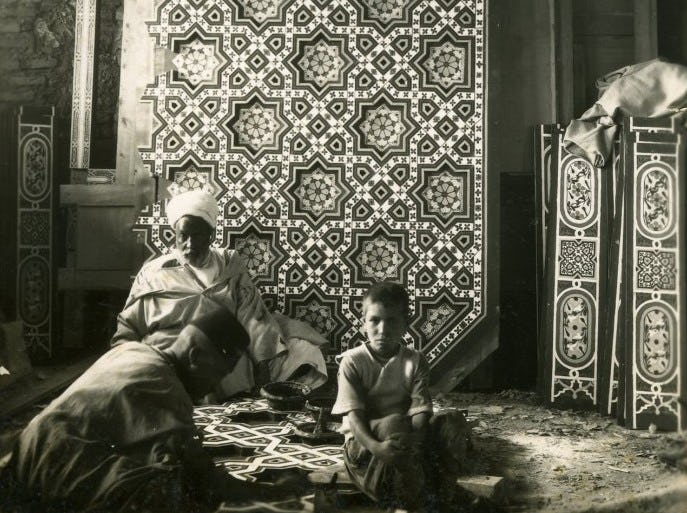Cobalt Blue and Turquoise Glazed Tile Panel with Molded and Bossed Decoration
Date13th century
PeriodIlkhanid
MediumStonepaste, polychrome pigments
DimensionsEach tile: 7 x 7 in. (17.8 x 17.8cm)
ClassificationsCeramics
Credit LineCourtesy of the Doris Duke Foundation for Islamic Art
Object number48.100a-c
DescriptionThis panel is composed of thirteenth-century ceramic tiles, cut to fit the stairway leading into the Central Courtyard of Shangri La. The tiles are arranged in an intricate geometric pattern composed of eight-pointed stars, punctuated by molded, glazed bosses. Although the central panel and the two stepped side panels differ visually, an identical geometric, mosaic-like pattern is present in each, creating overall harmony. The central, square-shaped panel is composed of molded, turquoise and cobalt blue tiles with floral elements, defined by bands of unglazed ceramic tile that form the intricate, interlacing “strapwork” pattern. The side panels are primarily composed of unglazed tile, with the turquoise and cobalt glazes applied in moderation.These tiles were likely acquired through Benjamin Mahboubian whose surname appears on the receipt for the purchase of the tiles in 1938. The uncle of Duke’s close contact, Iranian art dealer Ayoub Rabenou, Mahboubian was an Iranian archaeologist who conducted many commercial excavations throughout Iran during the 1920s and 1930s. These tiles are said to be from a site called “Seveh” (perhaps Saveh), where Mahboubian was known to have conducted commercial excavations. Similar architectural elements from his excavations are now at the Reza Abbasi Museum in Tehran.
The tile panels are similar to those excavated at Takht-i Sulayman (Persian for “Throne of Solomon''), the site of a royal summer palace located in the Azerbaijan province of north-western Iran. The palace was constructed by the second ruler of the Ilkhanid empire, Abaqa Khan around 1275 CE. The tiles that decorated the exterior walls of Takht-i Sulayman included geometric designs created from a combination of unglazed and robust underglazed tiles. Tiles from Takht-i Sulayman that are similar to those in DDFIA collection are housed at the Museum für Islamische Kunst in Berlin, who conducted the excavations at the site over a number of years.
On View
On viewCollections
17th century
17th century


















